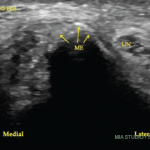“We’ve recognized that there seems to be some very significant efficacy with nerve growth factor inhibitors that has been limited by the toxicity profile,” says Dr. Kivitz. He adds that in some people with OA, their disease rapidly progresses in response to these agents, sometimes causing severe symptoms and necessitating joint replacement. The risk of these toxicities appears to be dose related.
Recent Fasinumab Study
The authors designed the prospective study to assess the efficacy and safety of fasinumab, with emphasis on the product’s joint safety. Participants had moderate or severe OA pain in the knee or hip. All had found inadequate relief with other treatments, such as acetaminophen, NSAIDs or opioids, or were unable or unwilling to take other treatments.
Participants received either placebo or subcutaneous fasinumab in doses of 1, 3, 6 or 9 mg, every four weeks for 16 weeks. Participants were then monitored for an additional 20 weeks. Because previous research demonstrated the risk of rapidly progressive OA is greater when NSAIDs are used concurrently with nerve growth factor inhibitors, patients were not permitted to use NSAIDs until at least 16 weeks after stopping fasinumab.2 A total of 342 participants completed the study.
Dr. Kivitz says, “This study had radiographs that were done routinely or for cause, and MRIs were performed to have active surveillance of any negative joint changes that may be occurring as a consequence of nerve growth factor inhibition.”
Imaging was performed at prescreening, end of treatment and week 36, as well as at additional times during the study if participants reported increased pain.
Efficacy: Participants taking fasinumab showed clinically relevant and statistically significant reductions in pain compared with those taking placebo as assessed by the pain subscore of the Western Ontario and McMaster Universities Osteoarthritis Index (WOMAC). These reductions in pain scores were noticeable from week 2 and continued throughout treatment. There was no clear relationship between fasinumab dose and degree of WOMAC improvement.
Similarly, all doses of fasinumab showed clinically meaningful and statistically significant differences in WOMAC physical function scores. The Patient Global Assessment scores were also reduced from baseline at all doses. Patients who had higher pain initially or who had previously had greater worsening after withdrawal of analgesic showed greater treatment effects overall.
Treatment-emergent adverse events: As a combined group, the fasinumab participants had a higher incidence of arthralgias (8% vs. 2%) and a higher incidence of worsened arthropathies (7% vs. 1%) than the placebo group. Five percent of the participants in the fasinumab group showed rapidly progressive OA with joint space narrowing on imaging, whereas no patients in the placebo group did. Overall, a dose-response relationship emerged, with one arthropathy in the placebo group, two in the 1 mg fasinumab group, four in the 3 mg fasinumab group, six in the 6 mg fasinumab group and 12 in the 9 mg fasinumab group. In this sample, no difference was found in the rate of joint replacement between the fasinumab and placebo groups, and primary osteonecrosis was not seen in either group.




